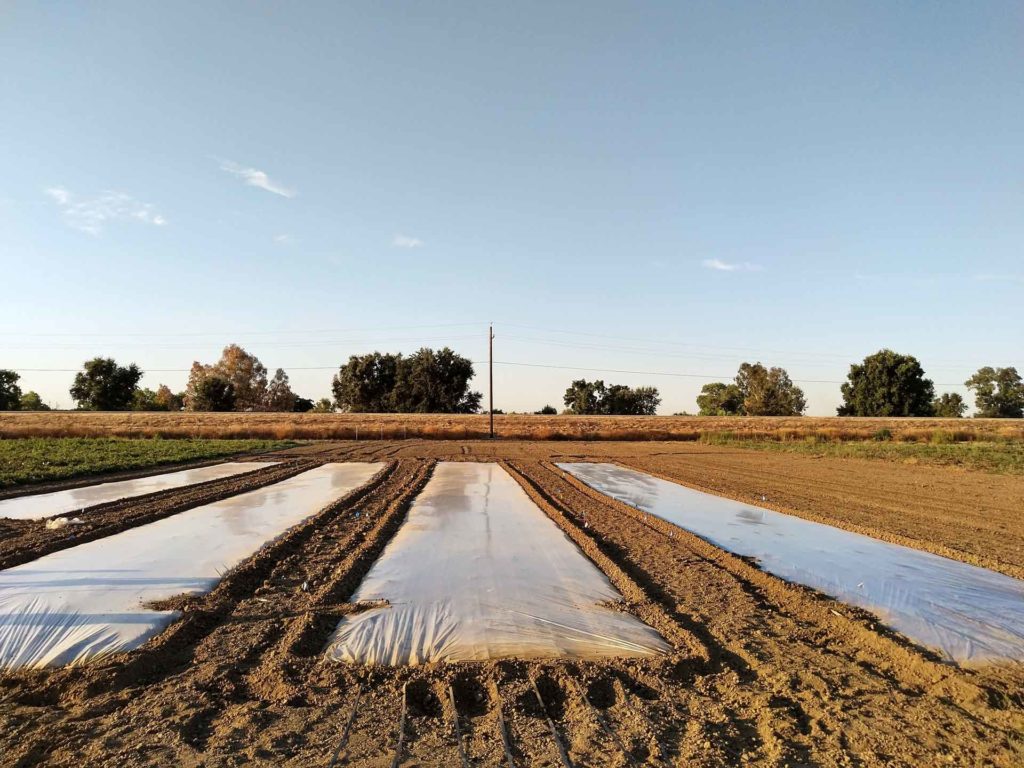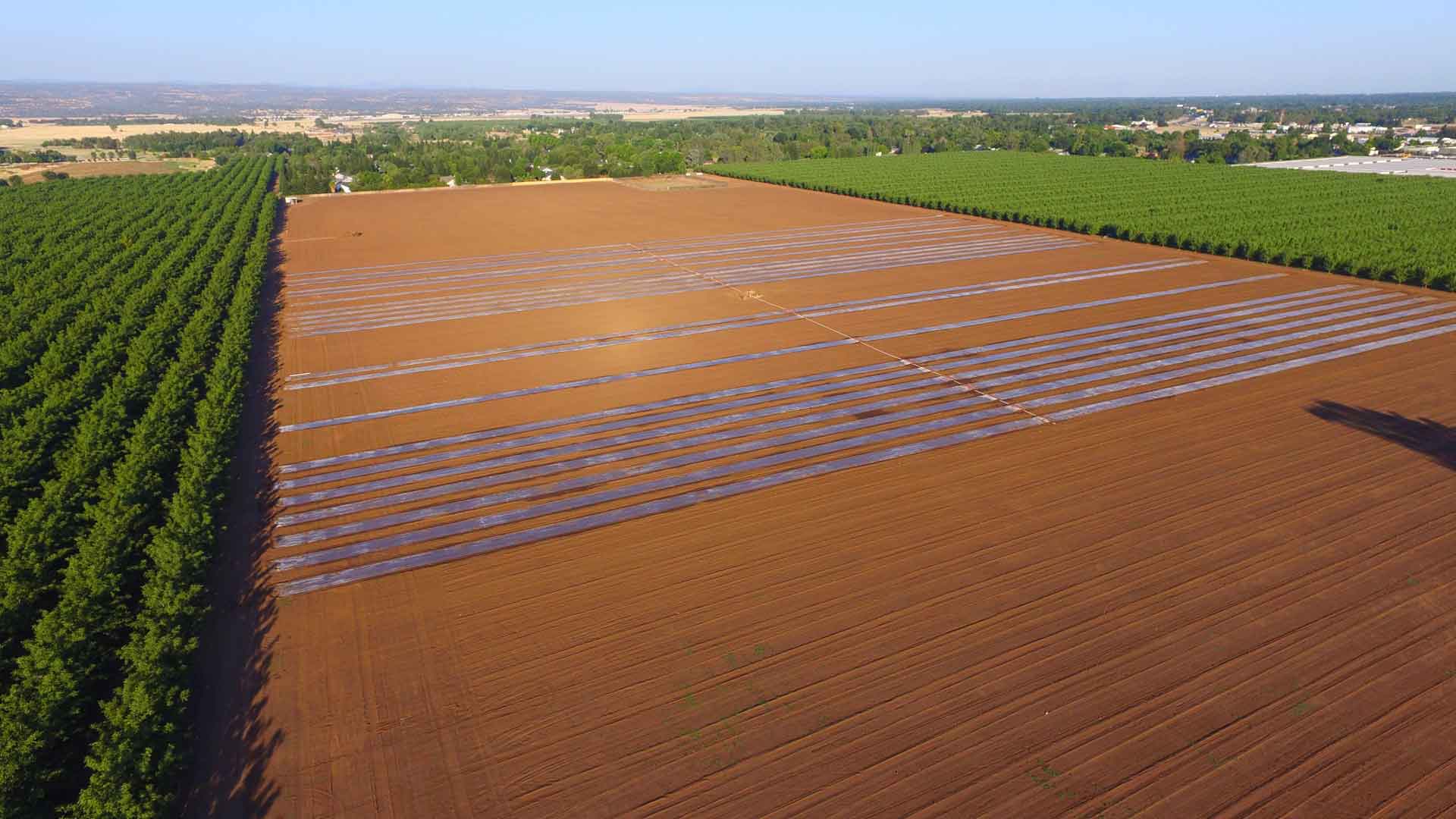Almonds are American’s favorite tree nuts by far1, but what many consumers do not realize is that the kernel we eat is only 27 percent of the nut. The majority of the almond nut—the hull and shell—is a byproduct.
It is estimated that 1.6 billion pounds of shells and 4.5 billion pounds of hulls are co-produced with kernels annually, a number that is only expected to increase as more almond trees are planted in California2.
Despite being inedible, hulls and shells are resources in their own right. The hull—similar to the flesh of other stone fruit like peaches and cherries—is rich in sugars and is used in dairy cattle feed, and the fibrous woody shell is used as animal bedding. Despite this, novel management options are needed as almond production outpaces demand for feed and bedding.
Confronted with this problem, University of California (UC) Davis researchers seek new uses for almond hulls and shells. The goal is to develop new ways to recycle these materials in orchards near where they are produced. With this in mind, soil amendment strategies are being explored in the context of biosolarization, an integrative soil pest management technique.
Biosolarization
Biosolarization, sometimes called anaerobic soil disinfestation or ASD, is a pre-plant soil treatment used to control soilborne pests. Biosolarization can promote inactivation of a broad range of soil pests that relevant to a variety of crops, including almond orchards. In the case of orchards, some of these pests—parasitic nematodes and other pathogens—feed on roots and can kill or stunt almond saplings. This is known as “replant disease” and can affect one third of California almond acreage if left untreated3.
Traditional solarization has been used as a pest management tool for decades. Simply by covering moist soil with clear plastic during the hot summer months can increase soil temperatures above 120 ˚F, more than enough to kill many pests. Unfortunately, solarization typically underperforms in orchards and other cropping systems as soil heating is limited to shallow depths and is critically dependent on the weather.
Organic matter such as almond hulls and shells can potentially solve this problem. By amending with organic matter before solarization, biosolarization may promote disinfestation to greater depths than traditional solarization, shorten the treatment duration, and guard against unpredictable performance owing to the weather and variable solar heating.
Biosolarization using hulls and shells presents multiple benefits to California agricultural soils by:
- Taking advantage of the local and abundant biomass to promote zero-waste crop production.
- Adding organic matter to the soil to promote soil health and water retention in the root zone.
- Providing more environmentally friendly pest management than conventional pesticides.
Why does it work? Biosolarization uses multiple modes of action that act together to kill soil pests. In addition to the soil heating, microorganisms in the soil consume and degrade the amended organic matter. In doing so, they convert the sugars from hulls and shells into organic acids—natural “biopesticides” that can quickly disperse into deeper soil layers. These compounds are toxic to many pests but are relatively safe for humans and benign soil microbes.
Depending on the temperature, biosolarization can eliminate pests in 8-10 days.

Soil Health Benefits
Recycling hulls and shells into the soil can deliver other benefits to soil health and crop production. For example, adding organic matter to soil increases water infiltration into soil along with the water holding capacity of soil, which can decrease runoff of rain water.
Adding these materials can also improve soil fertility. Almond hulls and shells naturally contain nitrogen and potassium. As these residues are degraded, these nutrients are released and become available to plants. In addition, almond hulls and shells are rich in carbon which can increase microbial biomass, thus promoting more rapid degradation and nutrient release.
Given enough time, hulls and shells can be converted into stable “soil organic matter” or humus. These complex polymers act as glue and improve soil structure; pores form between aggregates that allow aerated spaces for roots to grow and access nutrients. Humus also has high cation exchange capacity and allows soil to retain nutrients, acting as slow release fertilizer. Finally, humus is extremely stable and can remain in soil for hundreds of years, resulting in long-term carbon sequestration.
Lab Assessment of Biosolarization
In collaboration with the Almond Board of California and with additional support from the Western Center for Agricultural Health and Safety, researchers at UC Davis have worked to test and improve biosolarization using hull and shell amendments for use in both perennial and annual cropping systems. Before this technique was first implemented on fields, validation and fine tuning began in the lab.
The first step was assessing the unique properties of hulls and shells. The high sugar found in almond hulls could promote faster pest-inactivation, although fiber-rich shells potentially have longer lasting effects. Given these differences, they tested material from the Nonpareil variety, which has a thin and soft shell, a mixture of pollinator varieties, which have thick shells, and one residue stream comprised of only shells.
Ideal materials for biosolarization can induce pest-inactivating conditions in the soil in eight days or less. All materials were tested to ensure they met this threshold. Lab-scale biosolarization was performed using small soil ‘reactors’ that simulate soil amendment, moisture, and temperature conditions. Both the mixed pollinator and Nonpareil hulls and shells promoted rapid production of organic acid biopesticides in the soil, while the soils containing only shells proved too difficult for soil microorganisms to rapidly break down and no biopesticides were detected.
Interestingly, they observed that even before biosolarization, the addition of hulls and shells to the soil increased the level of organic acid biopesticides in the soil, namely succinic, acetic, and formic acids. These compounds, which naturally occur within almond hulls, can benefit pest inactivation during biosolarization and are further amplified as soil microorganisms transform the amendments.
After showing that hulls and shells could promote pest-inactivating conditions in the soil, root lesion nematodes (a common soil pest) were then exposed to the soil extracts. Results were clear: the more hulls and shells that were added to the soil, the more nematodes were inactivated.
The next step was to ensure the results from the lab translated to real-world scenarios, with uncontrollable variables such as weather, soil heterogeneity, and nematode behavior.
Bringing Biosolarization to Field Trials
In 2016, the Nicolaus Nut Company volunteered an eight-acre subset of their orchard for this collaboration. They had recently removed an old walnut orchard and were looking for fumigant-free pest control before planting almond saplings.
Thirty 10 by 950 foot plots were randomly treated with biosolarization using either Nonpareil hulls and shells or the pollinator variety hulls and shells. These were compared to two controls: traditional solarization and no treatment. Biosolarization lasted for six weeks, and the soil was monitored for ring and lesion nematode counts.
The results were promising. All nematodes were controlled at least nine days after treatment. This was likely due to the temperature extremes, which peaked over 140˚F, and high organic acid biopesticide concentrations during biosolarization.
Encouraged by the results, the Chico orchard was planted in the following winter and the soil continues to receive monitoring. Potentially harmful nematode populations are periodically tracked, and to date no re-emergence has been observed.
There have also been noted improvements in soil fertility. In the first year of growth, biosolarization increased total soil carbon, nitrogen, and potassium. This has potential long-term benefits to tree growth and yield.
The growth of the trees, spanning three varieties, continues to be tracked to measure how the trees adapt to the biosolarized soils and will eventually culminate in measurement of any changes to yield during the first harvest.
Beyond orchard applications, additional field work is exploring utilization of hulls and shells for biosolarization to manage soil pests in other crops, such as tomatoes and berries. By developing multiple biosolarization avenues, research aims to maximize opportunities to add value to California’s abundant supply of hulls and shells.
Interested growers should connect with UC to explore opportunities for demonstration trials.
Christopher Simmons
UC Davis Food Science and technology
http://foodscience.ucdavis.edu/people/christopher-simmons
References
- USDA 2016, Almonds lead in tree nut consumption
http://www.ers.usda.gov/data-products/chart-gallery/gallery/chart-detail/?chartId=93152
- ABC 2018, hull and shell production
http://www.almonds.com/sites/default/files/Almond_Almanac_2018_F_revised.pdf
- UCANR 2013, Managing the almond and stone fruit replant disease complex with less soil fumigant
http://calag.ucanr.edu/Archive/?article=ca.v067n03p128
















